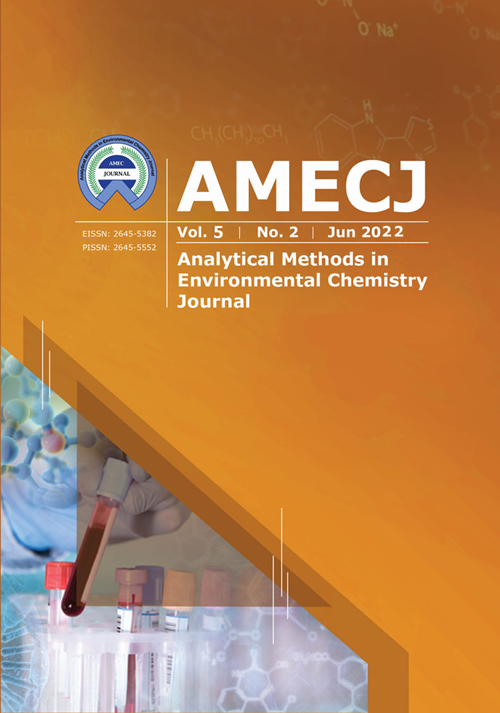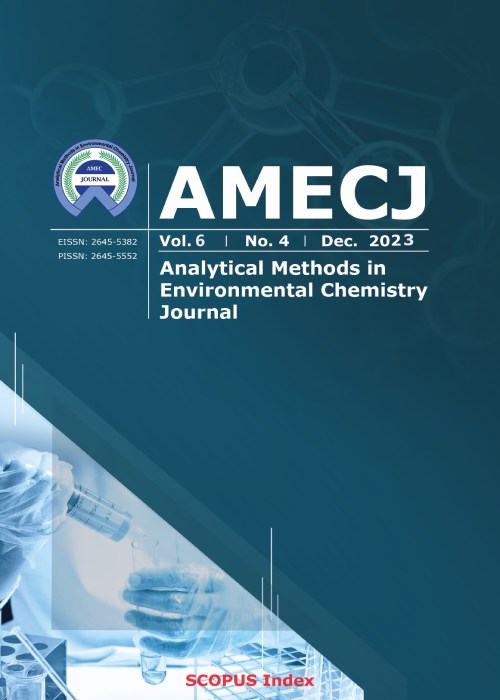فهرست مطالب

Analytical Methods in Environmental Chemistry Journal
Volume:5 Issue: 2, Jun 2022
- تاریخ انتشار: 1401/04/18
- تعداد عناوین: 7
-
Pages 5-23
In this research, the determination and complexation process between 3,3’-(2,2’-(4-methyl-phenylenesulfonamido)bis(ethane-2,1-diyl))bis(1-benzyl-3H-benzo[d]imidazol-1-ium)dibromide with Ni2+, Zn2+, Pd2+, Ag+, and Hg2+ cations in the binary mixture of methanol (MeOH) and water (H2O) at different temperatures (15, 25, 35 and 45ºC) were studied using a conductometric method. The results show that the stoichiometry of the complexes in all binary mixed solvents for Ni2+, Zn2+, and Pd2+ were 1:1 (M:L), while in other cases 1:2 (M:L) and 2:1(M:L). The stability constants (log ) of complex formation have been determined by fitting molar conductivity curves using a computer program (GENPLOT). The obtained data shows that in the pure methanol solvent system, the stability order is Ni2+< Pd2+<Zn2+<Hg2+<Ag+ and the complexation process seems more stable in pure methanol in most cases. The thermodynamic parameters ),,(οοοCCCSHG∆∆∆were determined conductometrically. The complexes in all cases were found to be enthalpy destabilized but entropy stabilized. The experimental data was tested by using an artificial neural network (ANN) program and was in good agreement with the estimated data.
Keywords: Analysis, Complexation process, Ligand, Conductometric method, Binary mixed solvent, Thermodynamic parameters -
Pages 24-38
In this work, cadmium metal–organic frameworks (Cd-MOF) has been prepared using a hydrothermal method and characterized by the SEM, elemental mapping, XRD, EDS, and BET analysis. The diazinon stability has been investigated in various pH (4-8) and temperature (298oK – 323oK) using UV-Vis spectrometer in the range of 230 – 280 nm, at its main absorption peak at 247 nm. Adsorption behaviors of diazinon on the Cd MOF were considered in different conditions. UV-Vis spectroscopy was used to monitor the removal of diazinon using the Cd MOF. The adsorption capacity of 138 mg g-1 was obtained. The effect of temperature (298oK -323oK), pH (4-8), adsorbent dose (1-7 mg), initial concentration (4-12 mg L-1), stirring speed (0-500 rpm), and adsorption kinetics were studied using batch rout. All the studied parameters have shown significant effects on the efficiency of removal of diazinon by the Cd MOF. The adsorption thermodynamic was investigated in the temperature range of 298oK to 323oK and it has shown the endothermic nature of adsorption of diazinon using prepared Cd MOF. The adsorption isotherm follows by the Langmuir isotherm model. It was demonstrated that synthesized adsorbent could be effectively used for the removal of diazinon from water.
Keywords: Cadmium Metal–Organic Fameworks, Diazinon, UV-Vis spectrometer, Adsorption kinetic, Adsorption thermodynamic, Pesticides -
Pages 39-50
In the present study, response surface methodology was employed to investigate the effects of main variables, including the initial MB concentration, hydrogen peroxide dosage, current density, and electrolysis time on the removal efficiency of MB using the electro-Fenton (EF) process. The MB concentration determination byU V-Vis spectrometer. The EF process degrades the MB contaminant molecules by the highly oxidizing species of the •OH. A quadratic regression model was developed to predict the removal of MB, where the R2 value was found to be 0.9970, which indicates the satisfactory accuracy of the proposed model. ANOVA analysis showed a non-significant lack of fit value (0.0840). Moreover, the predicted correlation coefficient values (R2=0.9915) were reasonably in agreement with the adjusted correlation coefficient value (R2=0.9958), demonstrating a highly significant model for MB dye removal. In addition, the obtained results showed 95.8% MB was removed in the optimum removal efficiency, including the initial MB concentration of 20 mg L-1, H2O2 dosage of 400 μL, and the current density of 7.0 mA cm-2, and electrolysis time of 10 min which was agreed with the predicted removal efficiency of 98.3%. Electrical energy consumption was found to be 0.163 kWh m-3. The constant rate value of Kapp at the optimum operating condition was 0.3753 min-1.
Keywords: Electro-Fenton process, UV-Vis spectrometer, Methylene blue, Response surface methodology, Degradation, Kinetic -
Pages 51-59
In this research, a miniaturized solid-phase extraction method based on pipette tip solid-phase extraction (PT-SPE) was employed for the determination of levofloxacin. Cobalt metal-organic framework (CoMOF) was used as an adsorbent. Levofloxacin was determined using high-performance liquid chromatography and UV detection (HPLC-UV). Important parameters that influence the extraction efficiency (i.e. pH, amount of adsorbent, extraction time, volumes of sample, and eluting solvent) were tested and optimized. Results indicated that the proposed method was validated over the range of 0.70 - 150.0 μg L-1. The relative standard deviation (RSD%) was below 2.75% for the levofloxacin. The limit of detection (LOD) of this method is 0.041 μg L-1. The preconcentration factor (PF) was obtained at 200 and the analysis time was around 10 min that confirming the reliability and accuracy of this method for extraction of levofloxacin. The PT-SPE procedure based on CoMOF adsorbent was efficiently extracted for levofloxacin more than 95%. In a static system, the adsorption capacity of CoMOF adsorbent for levofloxacin was obtained at 156.7 mg g-1 (n=10). The validation of results was successfully obtained for levofloxacin values based on the spiking real samples before determination by the HPLC technique.
Keywords: Cobalt metal-organic framework, Levofloxacin, Pipette tip, Preconcentration, Solid-phase extraction, High-performance liquid chromatography -
Pages 60-75
Carbonized cotton fabric/zeolite imidazolate framework-71/Fe3O4/polythionine (CCF/ZIF-71/Fe3O4/PTh) was fabricated, characterized, and applied as efficient magnetic sorbent in magnetic solid-phase extraction (MSPE) of cadmium from water and food samples before determination by flame atomic absorption spectrometry (FAAS). This modification of carbonized cotton fabric led to making a great surface area and porosity, increase extraction efficiency, and acceptable selectivity. The characterization of this proposed sorbent was performed by X-ray diffraction (XRD), field-emission scanning electron microscopy (FE-SEM), and Fourier transform-infrared (FT-IR) spectroscopy analysis techniques. The impact of several analytical parameters including pH, sorbent dosage, time of extraction, desorption condition, chelating agent concentration, the amount of salt and effect of potentially interfering ions on the selectivity and extraction recoveries of cadmium, were evaluated and optimized. In this proposed methodology, the limit of detection (LOD), the limit of quantification (LOQ), and relative standard deviation (RSD, n = 3) were found to be 0.21ng mL−1, 0.6 ng mL−1and lower than 3.0%,respectively. The validation and accuracy of the new advanced procedure were confirmed by applying the proposed procedure for certified reference materials (SRM1570A). Eventually, CCF/ZIF-71/Fe3O4/PTh can be utilized as a selective sorbent, for the rapid, accurate and sensitive determination of Cd (II) by magnetic solid-phase extraction tandem flame atomic adsorption spectroscopy (MSPE-FAAS) in water, tomato and cabbage samples.
Keywords: Magnetic solid-phase extraction, Flame atomic absorption spectrometry, Cadmium, Carbonized cotton fabric, Zeolite imidazolate framework-71, Fe3O4, Polythionine -
Pages 76-89
Mercury exposure can produce toxic organic compounds in the body. Also, mercury can potentially cause oxidative damage and cellular disorders. In this study, the determination of mercury values in urine and air of chloralkali workers based on copper nanoparticles functionalized in carboxylic carbon nanotubes (CuNPs@CNT-COOH) were obtained by cold vapor atomic absorption spectrometer (CV-AAS). The urine samples were determined by magnetic solid-phase extraction (MSPE) at pH 8.0. By measuring the mercury level in the air and the urine sample of workers, the level of oxidative stress (Malondialdehyde (MDA), Superoxide Dismutase (SOD) and Catalase (Cat)), Interleukin-6 (IL-6), and Tumor Necrosis Factor α (TNF-α) as the proinflammatory cytokines were measured in the subject group. The results revealed statistically significant differences in the mercury level of the urine samples in the case and control groups (p<0.001). Similarly, the malondialdehyde (MDA) level was significantly different between the two research groups (p<0.001). Catalase concentration was not significantly different in the two groups (p=0.059). The LOD and linear range for mercury determination in urine were achieved at 0.012 μg L−1 and 0.05-7.0 μg L−1, respectively. Workers’ exposure to mercury can significantly increase oxidative stress and inflammatory cell signaling molecules such as cytokines.
Keywords: Mercury, Air, and Urine, Magnetic solid-phase extraction, Oxidative stress, Copper functionalized carbon nanotubes, Cold vapor atomic absorption spectrometer -
Pages 90-104
In this study, a new flow injection analysis (FIA) based on a microfluidic flow cell (MFC) with a sample capacity of 40 μL is described. A Tungsten lamp directs light from a typical 2100P Portable Turbidimeter apparatus into a quartz flow cell through a round sidewall aperture of 2.0 mm and emerges through the identical aperture on the opposite side of the flow cell, where a photodiode array (light detector) detects the passing light. When compared to a traditional cuvette (25 mm x 60 mm round) with the same nominal route length, this technique improves sensitivity by around 4.0. This improvement is due to the use of a short, narrow internal diameter microfluid as the flow cell, which reduces physical dispersion. The designed flow cell has been evaluated by developing a turbidimetric method for the detection of promethazine in pure form or pharmaceutical dosages. The developed method is based on forming of a yellowish ion-pair association complex due to the reaction of promethazine and sodium tetraphenylborate (STPB) in an acidic medium. At the flow optimum conditions, the calibration curve (CC) and the limit of detection (LOD) for promethazine were obtained 0.5-90 μg mL-1 and 0.35 μg mL-1. respectively (R2 = 0.9955). The intra-day and inter-day precisions (RSD%) of the FIA-MFC method for measuring promethazine at concentrations of 20, and 50 μg mL-1 were achieved (2.0 and 1.6) and (0.8 and 1.2), respectively.
Keywords: Flow injection analysis, Microfluidic flow cell, Promethazine, Turbidity, Pharmaceuticals, Quality control analysis


